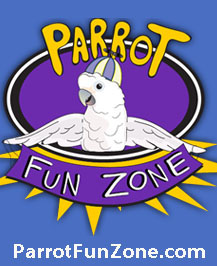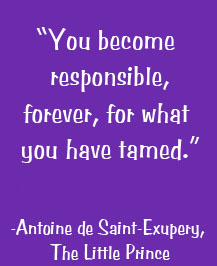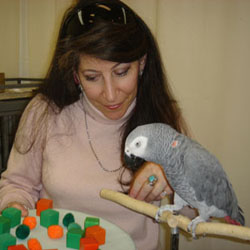 Birds learn to talk in order to communicate their needs; and once they understand the "power" of their words, the fact that they can get what they want by talking, many of them will learn to talk. Most of us cannot teach our birds exactly like Alex because 1) first, we do not have the time and 2) secondly, we do not always have partners that are free to help us conduct Model/Rival techniques. However, we can use some of the principles from the M/R system and assimilate them into an easier system for the "average" pet human, which we already know is well below the "average" African Grey Master! Nevertheless, this is what I shall attempt in this article.
Birds learn to talk in order to communicate their needs; and once they understand the "power" of their words, the fact that they can get what they want by talking, many of them will learn to talk. Most of us cannot teach our birds exactly like Alex because 1) first, we do not have the time and 2) secondly, we do not always have partners that are free to help us conduct Model/Rival techniques. However, we can use some of the principles from the M/R system and assimilate them into an easier system for the "average" pet human, which we already know is well below the "average" African Grey Master! Nevertheless, this is what I shall attempt in this article.
WHAT MADE ALEX LEARN?
First of all, we know that all wild birds learn their vocalizations by copying their parents and other flock members. They watch, they listen and they practice. They learn by socially interacting with their parental teachers. Similarly, Alex's trainers provided "Full Social Interaction" by interacting with him in the room, showing and demonstrating the object that he was learning to label and then giving him the object when he correctly labeled it.
Secondly, Alex was given the exact object that he was learning to label, which taught him that there was a direct relationship between the word and the three-dimensional object. He was able to "beak" it, to hold it, and to chew it. This is called "Reference," or learning the "meaning of the label."
Third, Alex was taught the "power" of words by requesting objects. In other words, he was taught their "Function" and how they were applicable to him. Once he learned to say, "Want paper," and the paper was given to him, he learned that he could obtain the object, if he said the correct word.
The Model/Rival system utilized two human trainers to socially interact with Alex. One person was the trainer and the other person was the model, after whom Alex was supposed to act, as well as his rival for the attentions of the trainer. We all know that Greys, and most parrots, can be "manipulative" and "competitive" for the attentions of their preferred humans, and the model/rival system does accentuate these two qualities.
On top of that, the trainer and model/rival switched roles where the trainer then became the model/rival to Alex and the model/rival became the trainer. This very important aspect taught Alex that he could also ask questions, which helped him learn to interact, rather than only repeat one part of the exchange.
Sessions were usually no longer than 20 minutes, sometimes daily and sometimes not at all, depending on the moods of Alex and the activities transpiring in his lab bird-room. Practice and social interactions were also important where much of the time, Alex was in full charge, ordering the student trainers and lab manager to fetch and do things for him. 'Want pa," he said, and he was brought pasta. "Want chair," and he was taken to the chair. "Want to go back!" and he was taken to his cage. "Want chair," and he was taken back to the chair. "Want showaa!" and he was given a spritz. "Want to go back," and he was taken back to the cage. Now, if I were an African Grey parrot, this would be heaven for me!
Alex was one special soul who took advantage of all of these aspects to prove far and beyond what anyone could ever imagine that a parrot with a walnut-sized brain could do. But I think there was one more key aspect that helped him do it. He was treated with respect as an associate by Dr. Pepperberg, and he was a part of the team that kept breaking through the barriers. I can imagine how exhilarated everyone must have felt every time that Alex learned to name paper..... to identify colors...to identify that there was no difference between objects...to identify numbers......to come up with his own concept of zero......to add numbers on his own, just to name a few accomplishments. Exhilaration, praise and respect build confidence and the combination thereof can help us do the impossible. That's why Alex was known as that "Damn bird!" by many scientists because he always proved them wrong....he showed them that an animal with bird-brains could actually think!
TRANSFERRING SOME OF THESE TECHNIQUES INTO OUR HOMES
We must remember that the focus of Alex's work was primarily on building cognition, instead of being taught how to speak English. Dr. Pepperberg had always claimed that Alex was taught an "English-based language-like code" instead of a true language that incorporates syntactic grammar. For example, he was taught short phrases, such as "Want Pa," instead of "I want my pasta treat." Therefore, he did not hold the "world's record" for knowing the most words or for speaking correct English; but he was the world's foremost African Grey scholar, working on his PhD for 30 years!
Most of us pet humans do not have the time to dedicate to help our birds truly develop Alex-level cognitive abilities; however, we can help them learn to communicate and interact within our human households. Therefore, our focus on teaching our birds could take on some of the techniques of Alex's training, but our emphasis should be more focused on our language-interaction with them, while at the same time, bringing in some of the aspects of the Model/Rival system to help provide the dimension of understanding, instead of mimicking.
The first step is to place your bird in a "socially interactive" environment, which means that we should have them with us in the family room, interacting with the family as much as possible, instead of spending most of their time in a bird room where they only learn to mimic language phrases without having any understanding of their meaning and purpose. This is where the "full social interaction" part of the Alex Pepperberg training comes in.
Secondly, include your bird in your conversations and talk about everything. Explain everything that you are doing, and explain to your bird what you will be doing with him, before you do it, such as taking him out of the cage.
In the beginning, place first emphasis on "action concepts," such as going to the perch, going to the window or requesting specific food. This provides the functionality, thus giving the bird a reason to want to learn the particular action concepts because it gives him "power" over his environment so that he can communicate his wants and needs.
Let's take the action of learning to request the perch. Talk about taking your bird to his perch in a few different sentences, always placing the name of the object at the end because birds and humans tend to remember the word at the end of a sentence. This is called "sentence framing."
- "Do you want to go to your perch?"
- "I'll take you to your perch."
- "It's a pretty green perch!"
- "Let's go to the perch. Up, up."
- "Here's the perch. Get onto the perch. Down. Good boy!"
Observe your bird and study what seems to interest him, and then talk a lot about that. For example, if he loves to watch the crows outside, sit with him by the window and talk about the crows with him. Again, do this in a sentence framing way where you place the word "crow" at the end of every sentence.
Every time that your bird says any word, give that object to him, whether or not you are trying to teach it to him. If you are trying to teach "perch," but instead, he says "water," bring him the water and then talk about it. I remember when I was first teaching Merlin to request various foods, I found myself scrambling. Every time that she requested apple, for example, I had to rush over to give her a piece of apple. Unfortunately, over time, I got lazy and did not force her to request the exact type of food every time, and so she now says "want some apple," which has become generic for "want some food."
Accordingly, every time your bird "copies" your phrases, make sure you answer back so that he learns that he can ask the questions too. For example, if he asks "Do you want some apple?" Go to the refrigerator and say, "Yes! I want some apple" and then eat the apple. Then talk about the "apple" in terms of "I" and then turn it around to "you" in terms of your bird.
Bird: "Do you want some apple?"
Pet human: Get piece of apple. "Yes! I want some apple. I love apple. Hmm, it's a yummy apple! Do you want some apple?"
Bird: "Apple." Or "aah-uhl"
Pet human: "Good bird!" Give him a piece of apple.
If you have a large household, encourage all members to interact with your bird verbally. Ask them to reverse roles, if they have time, so that your bird learns that everyone can interact by questioning and answering.
No matter what you are teaching your bird to label, be sure to give him the object to beak and chew, every time he either says the word or makes an attempt to do so. However, if it is food, please do not ever give your bird the same piece of food that you have put in your mouth because we have bacteria in our mouths that could make our birds seriously sick. Give him another piece of the food that you are teaching him to label.
MAKE LEARNING FUN
Again, enthusiasm and praise go a very long way. The more fun you are having while teaching your bird to talk, the more your bird will want to learn. This is the opportunity to be silly, act childlike (but do not use baby talk) and to actually have fun doing it.
My Merlin learned 7 animal sounds, and I taught her by first going with her interest. For example, she started to copy the bark of a friend's dog, and instead of getting upset, I turned it into a game. When Merlin barked, I asked "What does the doggie say?" Then every time that she barked right after I asked the question, I got so excited and praised her so much that it made her feel as if she had just won the lottery. Geez, wish she had! As a result, she learned to respond to my question with a bark.
Once we had the "what does the doggie say" Q&A down, I physically introduced her to the other animals that she learned to copy. Therefore, she knows that dogs, cats, roosters and ducks are other animals and what they look like: she was taught the reference, or the meaning of the words, dog and cat.
But getting into more serious learning matters, many pet humans utilize young children's learning boxes to teach their birds to talk. There are many good learning toys in Toys R Us and other toy stores that would be perfect teaching tools. When you shop for one, please also include safety as one of your requirements. Make sure there are not any buttons or switches or small objects that can be easily bitten off and swallowed, making your bird sick. Secondly, once you have found a good learning tool, you must first introduce it as a toy, which means very slowly. As with any new, strange toy, place it far away from the cage and play with it daily, acting joyous and excited about it, and eventually move it closer and closer to the cage. Do not ever place it in the cage until your bird is comfortable with it and wants to play with it. Play with it yourself as your bird would. For example, use your nose to act as a beak to punch buttons, which will teach your bird how to manipulate it.
TONALITY AND PHONETICS
Some parrots get so wrapped up in learning phrases that they do not practice so much on the tonality of their speech, which can result in a garbled sound that only you would recognize. Therefore, be sure to focus on helping your bird to speak the phrase that he is learning.
When I teach Merlin and Sweetpea, and now Kyo too, I sound out new words to them phonetically. For example, when teaching them "Merry Christmas," I would sound it out phonetically as: "Cr...Cr...Crr.. Cris.....mus. Cris...mus" and then I sounded out the word as it should be stated. At first, Merlin said, "Merry Christma," and so I had to emphasize the "mus" part at the end by saying "Christmus" quickly.
The positive about teaching in terms of phonetics is that it introduces sounds that the birds can play with. Merlin chooses different sounds that she wants to work on and then she combines them with other words that she has known, in order to make new ones. For example, she has been focusing on the "CH" sound lately, and she adds it to other words that I taught her as a young parrot, such as "ears.... Ch...ears....cheers!" Then I extend the "CH" sound with her and show her the meaning of other new words that she is learning to speak. For example, I say "ears...CH...Cheers" and act very bubbly and excited to show what cheers means. Then I say "air....CH...CH..air...chair!" and then I point to two or three different chairs, and sit on a few. Then I support this with sentence framing, such as "CH...air...chair. Look at the black chair. I sit on the chair. See the blue chair? CH...air...chair!"
All "talking birds" have the ability to speak phrases in human terms; however, some of them choose never to talk. This is not because they are not as smart, but possibly, they have found other ways to communicate with their humans and are not interested in the act of talking. Also, anecdotally, I have found that in the African Grey world, usually one specific bird in a "family flock," where there is more than one Grey, or other parrots, usually becomes the dominant talker and the other birds seem to acquiesce to the dominant or top talking bird of the flock.
Let's thank Alex and Dr. Pepperberg for showing us bird people that Greys, and other talking birds, do not mimic, but they can learn to communicate meaningfully when given the right tools and when treated with respect.
Copyright ©2008 Margaret T. Wright All Rights Reserved.
****************************
Maggie Wright is the author of the Barron's African Grey pet manual: African Grey Parrots: A Complete Pet Owner's Manual and Bringing Back The Magic. She is the creator and publisher of Nature's Corner® Magazine, she is owned by three beautiful African Grey parrots: Merlin Tewillager, Sweetpea and Kyaaro. Learn more at http://www.MaggieWright.net
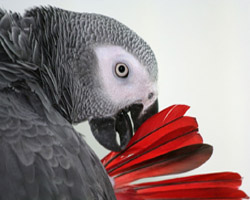 In the wild, parrots are challenged mentally every day just in their quest to find food and avoid predators as well as in their interactions with their flock mates.
In the wild, parrots are challenged mentally every day just in their quest to find food and avoid predators as well as in their interactions with their flock mates.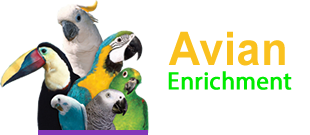

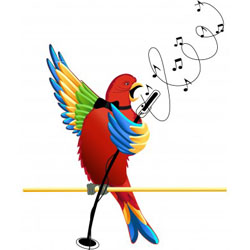 Music has a profound effect on our emotions as evidenced by its ability to transport us in time via our memories as well as to move us to tears or joyfulness. Depending on what we listen to, music can be calming and soothing or it can be energizing.
Music has a profound effect on our emotions as evidenced by its ability to transport us in time via our memories as well as to move us to tears or joyfulness. Depending on what we listen to, music can be calming and soothing or it can be energizing. Birds learn to talk in order to communicate their needs; and once they understand the "power" of their words, the fact that they can get what they want by talking, many of them will learn to talk. Most of us cannot teach our birds exactly like Alex because 1) first, we do not have the time and 2) secondly, we do not always have partners that are free to help us conduct Model/Rival techniques. However, we can use some of the principles from the M/R system and assimilate them into an easier system for the "average" pet human, which we already know is well below the "average" African Grey Master! Nevertheless, this is what I shall attempt in this article.
Birds learn to talk in order to communicate their needs; and once they understand the "power" of their words, the fact that they can get what they want by talking, many of them will learn to talk. Most of us cannot teach our birds exactly like Alex because 1) first, we do not have the time and 2) secondly, we do not always have partners that are free to help us conduct Model/Rival techniques. However, we can use some of the principles from the M/R system and assimilate them into an easier system for the "average" pet human, which we already know is well below the "average" African Grey Master! Nevertheless, this is what I shall attempt in this article.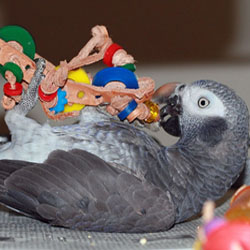 In the old days, parrots were just thought to be skillful mimics and where not given credit for the ability to learn and understand our language. To add further insult, the term Bird Brain was often used as a derogatory term towards individuals with, let's say, diminished brain capacity.
In the old days, parrots were just thought to be skillful mimics and where not given credit for the ability to learn and understand our language. To add further insult, the term Bird Brain was often used as a derogatory term towards individuals with, let's say, diminished brain capacity. 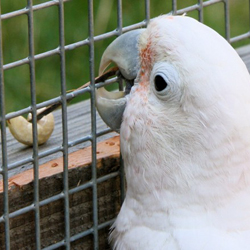 Scientists often refer to the use of tools as an indicator of intelligence within a species. Tools are defined as objects, other than a part of a bird's body, that are used for a useful purpose. Tool usage is an indicator of a species ability for inventive problem solving, flexibility of mind and their ability to learn and adapt.
Scientists often refer to the use of tools as an indicator of intelligence within a species. Tools are defined as objects, other than a part of a bird's body, that are used for a useful purpose. Tool usage is an indicator of a species ability for inventive problem solving, flexibility of mind and their ability to learn and adapt. 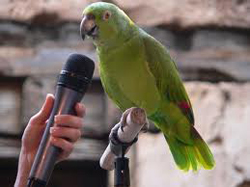 Due to their inherent intelligence, parrots have demonstrated the wonderful ability to “learn our language”. Much of this learning is done thru their intense observation of our interactions with other humans and household pets as well as our responses to certain situations such as a ringing phone or doorbell. Their ability to use complex and meaningful communication is one of the most enchanting aspects of these wonderful beings.
Due to their inherent intelligence, parrots have demonstrated the wonderful ability to “learn our language”. Much of this learning is done thru their intense observation of our interactions with other humans and household pets as well as our responses to certain situations such as a ringing phone or doorbell. Their ability to use complex and meaningful communication is one of the most enchanting aspects of these wonderful beings.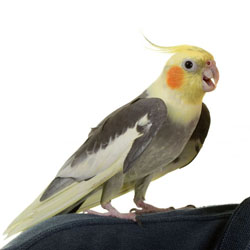 A parrot's ability to use and understand language is one of their most intriguing and endearing qualities. Parrots are unique in nature for their ability to use language. Other animals may have the capacity to learn and understand, for example chimpanzees and gorillas use of American Sign Language, but only parrots have the ability to speak to us in our own language.
A parrot's ability to use and understand language is one of their most intriguing and endearing qualities. Parrots are unique in nature for their ability to use language. Other animals may have the capacity to learn and understand, for example chimpanzees and gorillas use of American Sign Language, but only parrots have the ability to speak to us in our own language.

